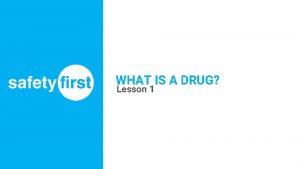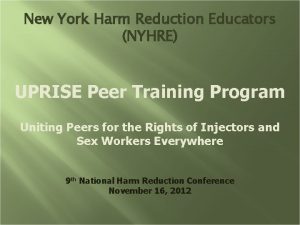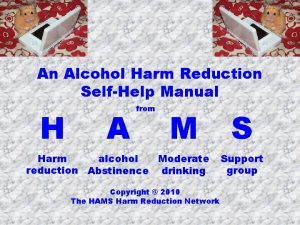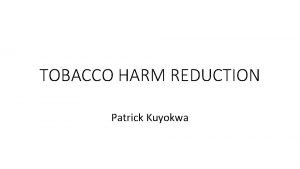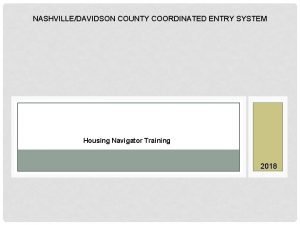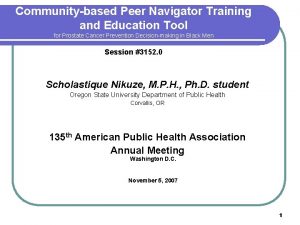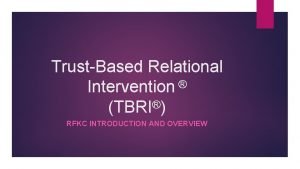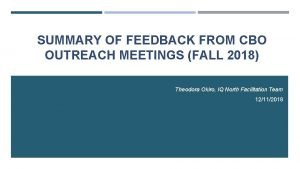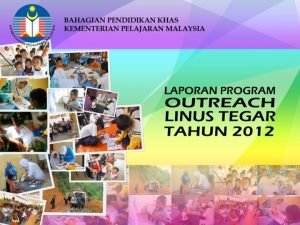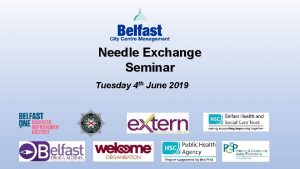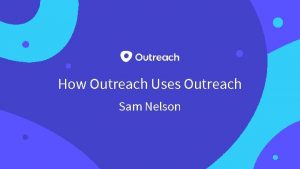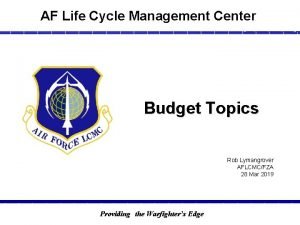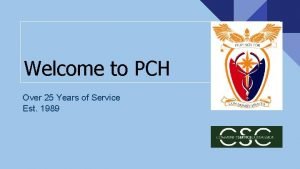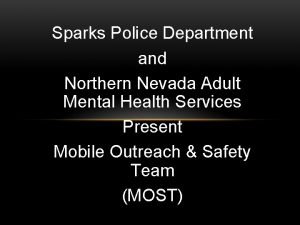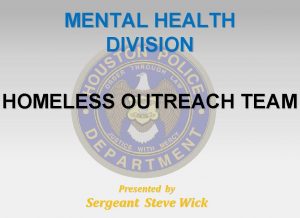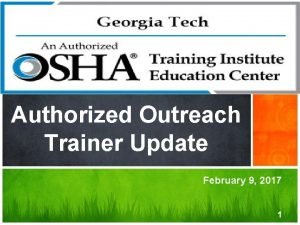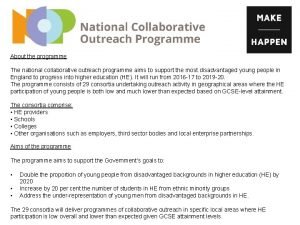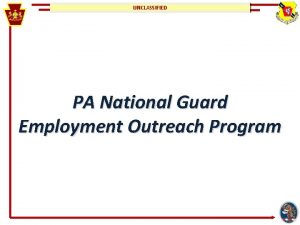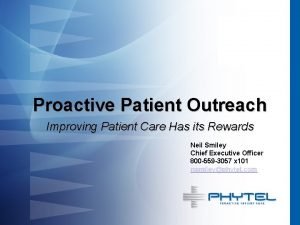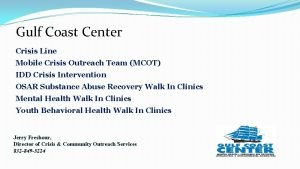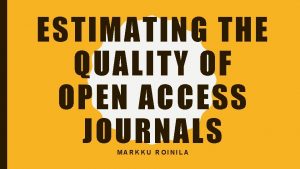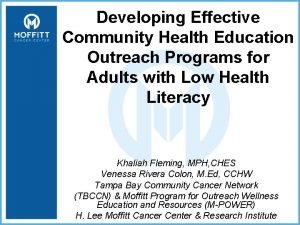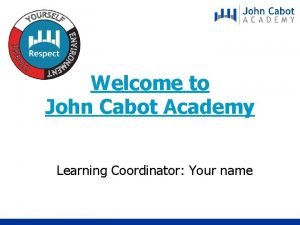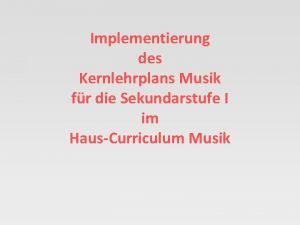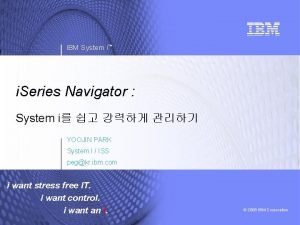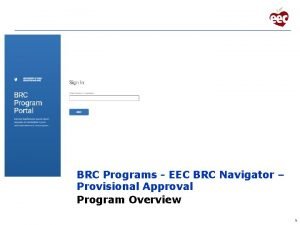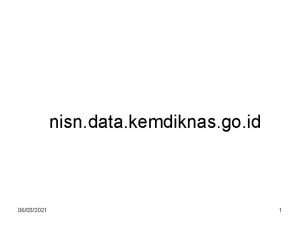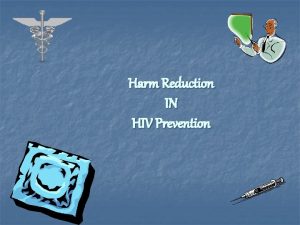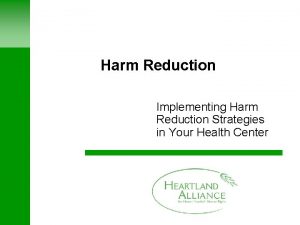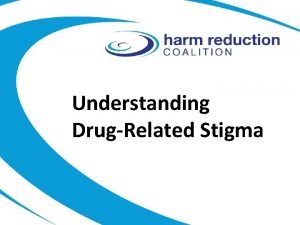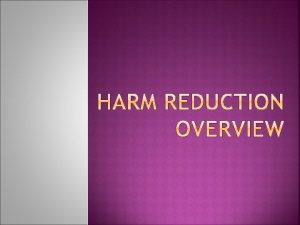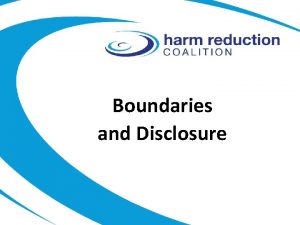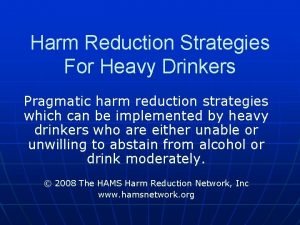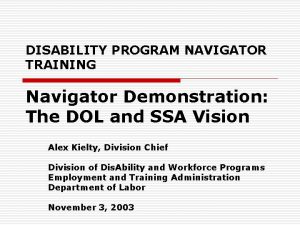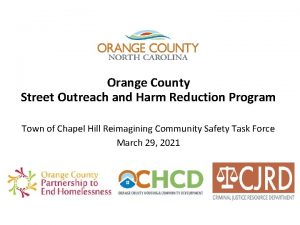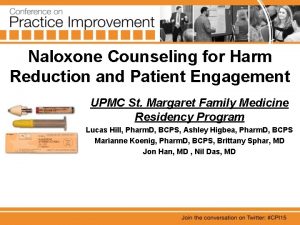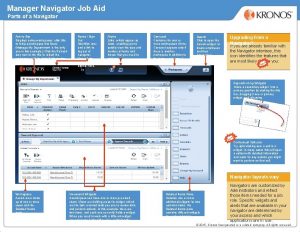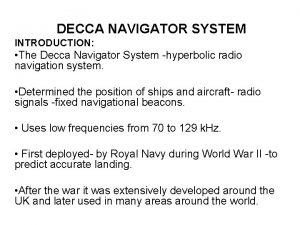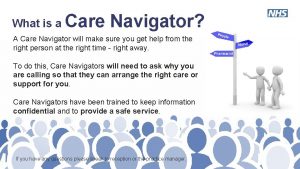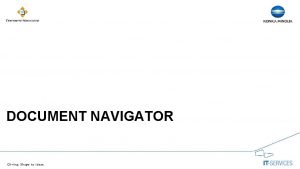Outreach Engagement Strategies HIV Harm Reduction Navigator Training













































- Slides: 45

Outreach & Engagement Strategies

HIV Harm Reduction Navigator Training • Commissioned by NYC DOH National Capacity Building Program for Health Departments and CBOs who have outreach staff and peers providing prevention services for people who use drugs. • Particular focus on PWID and health care issues. • Materials are drawn from HRC’s long experience and other Harm Reduction program peer training programs. You are experts in the field no matter how long you have been doing outreach. Everyone brings relevant experiences & perspectives to this work.

1. Workshop Overview

Group Agreements • Step up, Step Back • Non-Judgment • Use “I” Statements • Agree to disagree • Confidentiality • WAIT/PUSH/ELMO

Training Objectives By the end of this session you will be able to: 1. Discuss the benefits of outreach. 2. Recognize client needs, more effectively. 3. Examine the role of self-disclosure during outreach interaction. 4. Identify ‘best practices’ to ensure safety for both outreach providers and participants. 5. Provide more appropriate referrals.

Agenda Outreach and Engagement 1 Workshop Overview 2 Outreach 3 Effective Communication & Engagement Skills Break 4 Safety and De-escalation 5 Supportive Referrals 6 Closing & Evaluations

Glossary PWID—People Who Inject Drugs PWUD—People Who Use Drugs PLWHA—People Living with HIV/AIDS SUDs—Substance Use Disorders SAS – Syringe Access Services SEP – Syringe Exchange Program AOD – Alcohol & Other Drugs

• Sexual Orientation >> to whom we are sexually attracted • Gender Identity >> sense of self as male or female, neither or both • LGBTQI Lesbian, Gay, Bisexual, Transgender, Transsexual, Two Spirited, Questioning, Intersex

BRAINSTORM: What is the Purpose of Outreach?

2. Outreach “A process designed to contact individuals in non-traditional settings who might otherwise be ignored or underserved. ” The Open Health Services and Policy Journal; 2010. Olivet J, Bass. UK E, Elstad E, Kenney R, Jassil L. ; Outreach and Engagement in Homeless Services: A Review of the Literature

What is the Purpose of Outreach? q Make connections with people in the community. q Provide harm reduction supplies and education. q Offer support. q Provide a non-judgmental bridge between services.

What is the Purpose of Outreach? • Provide active listening • Provide key referrals: medical care, syringe exchange, overdose prevention, testing for HIV and Hep C, Hep A + B vaccinations Remember You are not expected to do everything or know all of the answers.

Summary of Outreach Skills • Philosophy of unconditional caring & respect • Ability to establish trust & communicate effectively • Equipped with appropriate information: knowledge of local resources relevant to target population, ability to make referrals • Organizational skills, record keeping • Ability to network with at-risk groups • Maintaining appropriate personal boundaries • Ability to work in target population’s community; actively participate in community events Adapted from NIDA, Community-Based Outreach Model: A manual to reduce the risk of HIV & Other Blood-Bourne Infections in Drug Users; 2000

ACTIVITY: Skills & Characteristics

Activity: Skills & Characteristics Group 1: What skills & characteristics do you think an outreach worker needs? Group 2: What gets in the way of effective engagement and communicationactions/behaviors/attitudes? Two groups – groups switch after 5 minutes, review and add to brainstorming lists. Report back to larger group for discussion.

Foto: CDC/Amanda Mills 3. Effective Communication & Engagement Skills

Effective Communication DOES NOT… X Act as “expert” or do most of the talking X Diagnose, label, judge X Argue the person has a problem and needs to change X Prescribes solutions X Pressure, threaten consequences, act punitively

Stages of Change Transtheoretical Model of Behavior Change Pre-Contemplation “Not considering it” Return/Relapse Contemplation “Stop doing it” “Thinking about it” Maintenance Preparation “Staying with it” “Planning to do it” Action “Doing it”

1. PRE-CONTEMPLATION “Not Considering It” 2. CONTEMPLATION “Thinking About It” 3. PREPARATION “Planning To Do It” 4. ACTION “Doing It” 5. MAINTENANCE “Staying With It” 6. RETURN/RELAPSE “Stop Doing It”

Motivational Interviewing (MI) Basics Motivational Interviewing is a directive, client-centered counseling style for eliciting behavior change by helping clients to explore and resolve ambivalence. Miller and Rollnick

Directive and Client-Centered • Focused and goal-directed • Elicits exploration of ambivalence • Guides client toward acceptable resolution that stimulates behavioral change • Change comes from the participant, its not imposed • Provider and Participant relationship is collaborative.

Expresses Empathy • Understanding of individual’s perspective and frame of reference. • Explores fears or hesitations regarding change; comfort with current habits, rituals, environment, etc. • Counselor conveys understanding and builds an alliance through reflective listening.

“I don’t know why everyone is so upset I’m still getting high now and again…it’s not like I’m doing it everyday anymore!” “So others have expressed concerns about your drug use, but you don't feel the same concern because you are not using as much as you once did. ” Express Empathy

Encourages Self-Efficacy & Motivation • Does the client perceive change as being important? • Look for recognition around issues (change talk): “I guess it doesn’t really make sense. I don’t even enjoy getting high anymore. It’s just making my problems worse. ” • Is the client confident they’re able to make the change? • Look for optimistic expressions around change.

Encourages Self-Efficacy & Motivation • Reinforces the perceived importance of making a change. “That’s great you feel ready to make a change, and moderating your use sounds like a really positive step!” • Highlight strengths, resources, abilities, history, and belief that change is possible. • Expect success!

Self-Disclosure The role of personal information during outreach: • Disclosure can be a powerful tool. • Keep boundaries in mind. • Always consider the reasons why you are sharing this information – how will this information benefit the participant?

Engagement Toolbox q Ask open-ended questions q Use affirming statements q Reflective listening & summaries q Decision balance q Change plan

Open-Ended Questions • Let the client do most of the talking • Open-ended Q do not invite brief or Yes/No answers • Open questions begin with: what, why, how, describe. Examples: – What do you like about drinking alcohol? – How do you think it will be different if you tell your partner your Hep C status? – Tell me about your cocaine use. * *Colombo Approach

ACTIVITY: Flip That Question!

BREAK

4. Safety and De-escalation Safety First: • Always let your supervisor know where you are. • Go out in pairs, watch each other’s backs. • Do you have to go out alone? • Don’t approach people who are signaling they don’t want to be approached. • Don’t interrupt sales of drugs or sex. • Don’t work sick.

Safety and Outreach • Introduce yourself and let people know what you’re doing. • And why. • Wear an agency ID or carry documentation identifying you as a peer just in case. • Trust your instincts! • If you are uncomfortable in a situation, walk away from it. Make contingency plans for worst case scenarios agreed upon by the whole team.

q What is your agency’s protocol in the event you are stopped by police? q Or had an accidental needlestick? q Make this plan and identify a point-person to call at any hour when workers are conducting outreach. q Check the weather. q Keep supervisors informed of your location & activities.

Crisis Intervention Strategies • Crises occur when a person can not utilize coping skills to manage stress from a difficult situation. • Providers can help the client feel an immediate deescalation of anxiety, fear and panic. • Maintaining your personal safety is key!

Example Strategies and Action Steps • Project calmness; acknowledge and validate feelings; encourage the person to talk; listen closely and patiently. • Maintain a relaxed and attentively open posture; nonchallenging or threatening. • Point out choices/options, break big problems into smaller ones. • Position yourself so that have easy access to an exit if you are in an office or private space.

Maintaining Safety: What to Avoid in a Crisis T. A. C. O. S. X X X Threatening Arguing Challenging Ordering Shaming

5. Supportive Referrals Identifying client needs that cannot be met by yourself or agency (beyond base of knowledge, skills or responsibility) and assist participants in accessing available support systems and community resources.

Providing Supportive Referrals Referral Forms Communication with a Contact Provide Assistance Timely Follow-Up Re-Assess Plan of Care

Building a Strong Referral Network

ACTIVITY: Referrals

Group Activity: Referrals • Break into groups • Each group can start at opposite sides of the room, brainstorming local referrals for each category • One person from each group report back examples of referral options to large group for discussion or expansion

Group Activity: Referrals q Hep C, HIV, STI Testing (including Hep A + B vaccinations & care) q HIV, Hep C Primary Care and Treatment q Dental Care q Mental Health Services q Support Groups q Alcohol & Substance Use Treatment (Suboxone, MMTPs, in/out-patient, ) q Harm Reduction/ Syringe Access Programs q Overdose Prevention q Case Management & Housing

Reflective Practice: Outreach & Engagement Identify What are specific engagement skills you can improve on during your interactions with participants during outreach? Think about “desirable characteristics of outreach workers. ” Explain Describe important issues related to self-disclosure to a colleague or in group supervision, including an example where you were uncertain whether or not to disclose. Apply After identifying areas for improvement, begin to implement your engagement strategies. Discuss how it impacted your outreach encounters and share during supervision and/or with your peers.

6. Closing & Evaluations Anonymous Surveys: Put completed surveys in the folder

HRC thanks you for participating in this workshop!
 Harm reduction strategies
Harm reduction strategies Hams drinking chart
Hams drinking chart New york harm reduction educators
New york harm reduction educators Harm reduction programme
Harm reduction programme Harm reduction worksheets
Harm reduction worksheets Harm reduction
Harm reduction Housing navigator training
Housing navigator training Peer navigator training
Peer navigator training Tbri levels of response
Tbri levels of response Engagement strategies for high school students
Engagement strategies for high school students Risk reduction strategies for new entry exploitation
Risk reduction strategies for new entry exploitation Cost reduction strategies
Cost reduction strategies Risk reduction strategies for new entry exploitation
Risk reduction strategies for new entry exploitation Pharmacy cost reduction strategies
Pharmacy cost reduction strategies Risk reduction strategies for new entry exploitation
Risk reduction strategies for new entry exploitation Theodora okiro
Theodora okiro Matlamat program
Matlamat program Drug outreach team belfast
Drug outreach team belfast Sam nelson outreach
Sam nelson outreach Nesac outreach facility
Nesac outreach facility Afman 65-605
Afman 65-605 Pch outreach program
Pch outreach program Northern nevada adult mental health
Northern nevada adult mental health Hpd mental health division
Hpd mental health division Georgia tech osha outreach portal
Georgia tech osha outreach portal National collaborative outreach programme
National collaborative outreach programme Outreach program
Outreach program Phytel appointment reminder
Phytel appointment reminder Gulf coast center angleton texas
Gulf coast center angleton texas Research outreach predatory
Research outreach predatory Cires education and outreach
Cires education and outreach Community health education outreach programs
Community health education outreach programs Stairway safety presentation
Stairway safety presentation John cabot portal
John cabot portal Prince henry the navigator ap world history
Prince henry the navigator ap world history Kuder navigator
Kuder navigator Prince henry young
Prince henry young Pin navigator
Pin navigator Medienkompetenznavigator
Medienkompetenznavigator Lehrplan navigator
Lehrplan navigator System i navigator
System i navigator Aws wind navigator
Aws wind navigator Nuclide navigator
Nuclide navigator Spain and portugal
Spain and portugal Brc program
Brc program Bagian tengah navigator palette disebut…
Bagian tengah navigator palette disebut…
